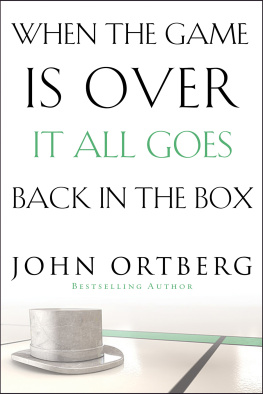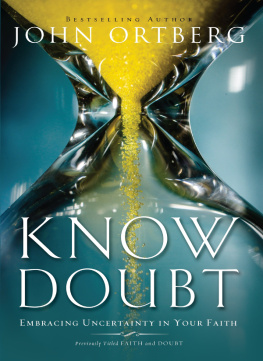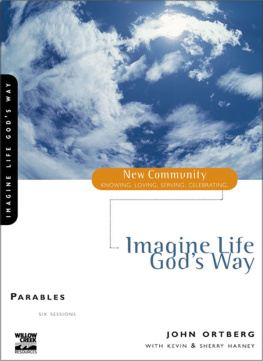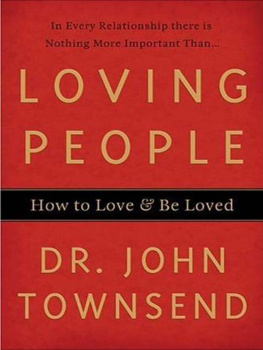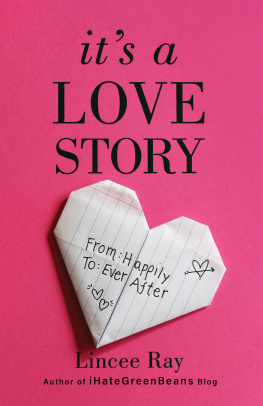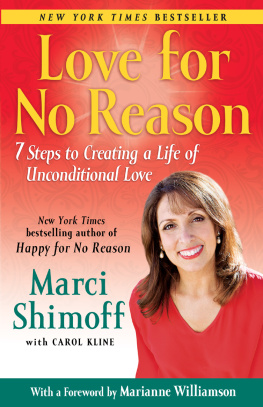
Resources by John Ortberg
God Is Closer Than You Think (book, audio, curriculum)
Everybodys Normal Till You Get to Know Them
(book, audio, curriculum)
The Life Youve Always Wanted
(book, audio, curriculum)
Love Beyond Reason (book)
If You Want to Walk On Water,Youve Got to Get Out of the Boat
(book, audio, curriculum)
ZONDERVAN
Love Beyond Reason
Copyright 1998 by John Ortberg
All rights reserved under International and Pan-American Copyright Conventions. By payment of the required fees, you have been granted the non-exclusive, non-transferable right to access and read the text of this e-book on-screen. No part of this text may be reproduced, transmitted, down-loaded, decompiled, reverse engineered, or stored in or introduced into any information storage and retrieval system, in any form or by any means, whether electronic or mechanical, now known or hereinafter invented, without the express written permission of Zondervan.
ePub Edition July 2009 ISBN: 0-310-86289-2
Requests for information should be addressed to:
Zondervan, Grand Rapids, Michigan 49530
Library of Congress Cataloging-in-Publication Data
Ortberg, John
Love beyond reason : moving Gods love from your head to your heart / John Ortberg.
p. cm.
Includes bibliographical references.
ISBN-10: 0-310-23449-2 (softcover)
ISBN-13: 978-0-310-23449-4 (softcover)
1. LoveReligious aspectsChristianity. 2. Godlove. 3. GodWorship and love. 4. Christian life. I. Title.
BV4639.078 1998
231'.6dc21 98-26062
All Scripture quotations, unless otherwise indicated, are from the New Revised StandardVersion, copyright 1989 by the Division of Christian Education of the National Council of the Churches of Christ in the United States of America. Used by permission of Zondervan. All rights reserved.
Scriptures marked NIV are from the Holy Bible: New International Version. Copyright 1973, 1978, 1984 by International Bible Society. Used by permission of Zondervan. All rights reserved.
All rights reserved. No part of this publication may be reproduced, stored in a retrieval system, or transmitted in any form or by any meanselectronic, mechanical, photocopy, recording, or any otherexcept for brief quotations in printed reviews, without the prior permission of the publisher.
Interior design by Sherri L. Hoffman
To
Ian Pitt-Watson,
David Hubbard,
Lew Smedes, and
Rich Mouw
this book is gratefully dedicated
CONTENTS
I AN PITT-WATSON WAS THE first preacher Id ever heard who was also a poet, an artist. When listening to other preachers I often felt informed, convicted, or inspired. When listening to Ian it was sometimes as if a veil had parted, and I suddenly wasnt sure if I was sitting in a classroom in Pasadena or in first-century Jerusalem. To listen to Ian preach was often to find yourself suddenly,mysteriously, hopelessly immersed in the presence of Godto your own surprise most of all. Two of the great gifts of my life were the gifts first of his teaching, then of his friendship.
Maybe his greatest sermon was the story of two kinds of lovethe love that seeks value in its object, and the love that creates value. Ian never published it, except a few bits to illustrate the craft of preaching. But it provides the central idea for the first chapter, the metaphor of a rag doll. The stories and experiences I tell in the first chapter are my own. Pandy really exists and is doing quite well in San Diego. But the inspiration came from Ian.
I also want to thank several people who read parts or all of this manuscript: Ruth Haley Barton, Gerald Hawthorne,Rich Mouw, Lauri Pederson, Scott Pederson, Lew Smedes, and Jodi Walli. Jack Kuhatschek was again a great help and friend as an editor, and Jim Ruarks diligent efforts added clarity where it was sorely needed.
To my wife,Nancy, for her candor and encouragement, and to Laura, Mallory, and Johnny, I owe the unpayable debt of all those who are loved despite their raggedness.
Love slays what we have been that we may be what we were not.
H ER NAME WAS PANDY. She had lost a good deal of her hair, one of her arms was missing, and, generally speaking, shed had the stuffing knocked out of her. She was my sister Barbies favorite doll.
She hadnt always looked like this. She had been a personally selected Christmas gift by a cherished aunt who had traveled to a great department store in faraway Chicago to find her. Her face and hands were made of some kind of rubber or plastic so that they looked real, but her body was stuffed with rags to feel soft and squeezable, like a real baby. When my aunt looked in the display window at Marshall Fields and found Pandy, she knew she had found something very good.
When Pandy was young and a looker, Barbie loved her. She loved her with a love that was too strong for Pandys own good. When Barbie went to bed at night, Pandy lay next to her. When Barbie had lunch, Pandy ate beside her at the table. When Barbie could get away with it, Pandy took a bath with her. Barbies love for that doll was, from Pandys point of view, pretty nearly a fatal attraction.
By the time I knew Pandy, she was not a particularly attractive doll. In fact, to tell the truth she was a mess. She was no longer a very valuable doll; Im not sure we could have given her away.
But for reasons that no one could ever quite figure out, in the way that kids sometimes do, my sister Barbie loved that little rag doll still. She loved her as strongly in the days of Pandys raggedness as she ever had in her days of great beauty.
Other dolls came and went. Pandy was family. Love Barbie, love her rag doll. It was a package deal.
Once we took a vacation from our home in Rockford, Illinois, to Canada. We had returned almost all the way home when we realized at the Illinois border that Pandy had not come back with us. She had remained behind at the hotel in Canada.
No other option was thinkable. My father turned the car around and we drove from Illinois all the way back to Canada. We were a devoted family. Not a particularly bright family, perhaps, but devoted.
We rushed into the hotel and checked with the desk clerk in the lobbyno Pandy. We ran back up to our roomno Pandy. We ran downstairs and found the laundry roomPandy was there, wrapped up in the sheets, about to be washed to death.
The measure of my sisters love for that doll was that she would travel all the way to a distant country to save her.
The years passed, and my sister grew up. She outgrew Pandy. She traded her in for a boyfriend named Andy (who, oddly enough,was even less attractive than the doll Pandy).
Pandy had not been much of a bargain for a long while, and by now the only logical thing left to do was to toss her out. But this my mother could not bring herself to do. She held Pandy one last time, wrapped her with exquisite care in some tissue, placed her in a box, and stored her in the attic for twenty years.
When I was growing up I had all kinds of casual playthings and stuffed animals. My mother didnt save any of them. But she saved Pandy. Want to guess why? (When I was younger I thought it was perhaps because my mother loved my bratty little sister more than she loved me.)
The nature of my sisters love is what made Pandy so valuable. Barbie loved that little doll with the kind of love that made the doll precious to anyone who loved Barbie. All those tears and hugs and secrets got mixed in with the rags somehow. If you loved Barbie, you just naturally loved Pandy too.
Next page

